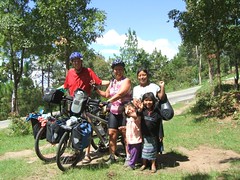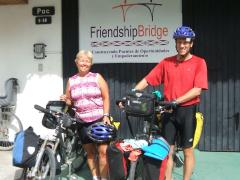Inuvik to Ushuaia
Leaving Mexico and entering Guatemala.
I had heard so many different stories about this country, I did not know what to expect. Would the border crossing be dangerous, with hordes of kids overwhelming us and perhaps slashing our pannier? Would the border immigration officials try to charge us horrendous fees? Would the money changers rip us off? As we rode the hot flat road toward the border, my stomach had a twisted knot and my head hurt. What would happen to us?
Riding the Guatemala Highlands
We didn't really know what we were getting into when we heard about the beautiful new road that runs east from Huehuetenango (Way-Way-tenango) - everybody said it had just opened and was a great new road. But it sounded like low traffic and a good road, so we took it. It was probably some of the best riding we've had on the trip. Almost no traffic, beautiful road surface, and sometimes even and shoulder!
It's all huge, brutal, beautiful green mountains. We've never seen so much green. The landscape looks like a quilt because of the efficient agricultural use of this land. In every village and along every road we meet colorful indigenous people who smile and say hi or call out to us, impressed by our trip. Often we hear someone yelling out "bye-bye" in English or the young children come running out of their house, waving and in unison cryout "Gringo Gringo". Nancy usually responds with Ninos! Ninos! (children, children) and gives a hearthy wave back.
In every village the people have a different "tipica" outfit, and the women's outfits are just absolutely gorgeous. I don't know what it would be like to live in a village where all the women wore the same dress every day, but the dresses they wear are beautiful. And each one tells a specific story; the women weave their own "huipiles", and it often requires three months of near-full-time effort to weave one. read more here... lee mas aquí... »
Volunteering for Kiva.org - A Major Change of Pace!
As we were riding through Mexico, we were really impacted by the poverty we saw, and became tremendously interested in the concept of microfinance, the practice of offering small loans ($100-$1000, usually), without requiring collateral, to tiny businesses. It turns out that last year's Nobel Peace Price winner, Mohammed Yunus, is the originator of the concept, and his book "Banker to the Poor" is tremendously inspiring. What they did with tiny, collateral-free loans in Bangladesh is the most hopeful story about alleviating poverty that I've ever heard in my life.
Where We Are - Early July 2007
In the past month we rode from the southern part of Oaxaca, Mexico along the Pacific coast for a few days, then up a huge climb into the mountains of Chiapas. Nancy liked the climate so much when we got up into the mountains that we stayed for two weeks and she studied Spanish. When we got going again, it was just a few days into Guatemala and then a glorious week or so exploring the green, mountainous western highlands of Guatemala.




